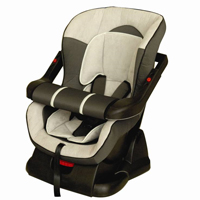Posts Tagged ‘child passenger safety seat all’
New Child Safety Seat Recommendations
The National Highway Transportation Safety Administration (NHTSA) and the American Academy of Pediatrics have issued new safety recommendations to protect young children from motor vehicle accidents. They are advising parents to keep children in rear-facing seats until age two, or until they reach the maximum height and weight requirements for the seat.

The previous recommendation from 2002 was also for children to ride in rear-facing car seats until they reached the maximum height and weight requirements – or until the child had reached a minimum of age one and 20 pounds. Using this standard, many parents turned the car seats around when their child reached age one.
The NHTSA and the American Academy of Pediatrics issued the recommendation citing a 2007 study in the journal Injury Prevention, which showed that children under age two traveling in rear-facing seats are 75 percent less likely to die or suffer severe injuries in car accidents.
The two groups made additional recommendations for booster seats, saying children should ride in them until they have reached four feet nine inches tall and are between eight and 12 years old.
The groups also recommend children ride in the backseat until they are 13.
The new recommendations come as motor vehicle accident deaths among children under age 16 have decreased significantly in recent years – 45 percent between 1997 and 2009, according to the American Academy of Pediatrics.
But motor vehicle accidents remain the leading cause of death for children ages four and older. More than 5,000 children, teens and young adults up to age 21 die in motor vehicle accidents each year. For every fatality, 18 children are hospitalized and more than 400 require medical care.
Massachusetts law requires child safety seats to protect children from car accidents. Children must be secured in child safety seats until they turn 7 years old.
Click here for more details about Massachusetts’ Child Passenger Safety Law.
Read More
Child Passenger Safety Week Time to Check Your Child’s Car Seat
The National Highway Transportation Safety Administration (NHTSA) hosts Child Passenger Safety Week from Sept. 19 to Sept. 25, providing parents an opportunity to check the traveling accommodations for those they hold most dear: their children.
The NHTSA estimates three out of four parents are not properly restraining their children in the car. But car and booster seats provide your child the greatest amount of protection and are especially important in light of the fact that motor vehicle crashes are responsible for the majority of deaths among children ages four to eight years old. Child safety seats reduce injury rates by 58 percent.
Massachusetts law mandates use of child safety seats. The law, which was expanded in July 2008, now requires parents to restrain children five to seven years of age or up to 4′ 9″ tall. Previously, child safety seats were required for children under 5 years of age and under 40 pounds.
The new law also requires children ages eight to twelve to wear a safety belt.
Drivers who violate this law can be stopped by police and face a $25 fine, but the real price is far greater in respect to your child’s safety.
One problem parents face in securing their children is the proper method changes with age. Click here to learn more.
If you’re a parent, make sure your child’s safety seat is properly installed. On Sept. 25, police stations and other inspection sites across Massachusetts will be participating in National Seat Check Saturday. Visit this website and search for an inspection station near you.
Read More

